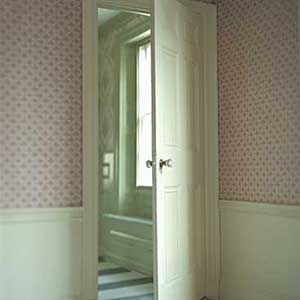
Fitting Old Doors in New Frames
Salvaged wood doors are like secondhand suits—for a perfect fit, you'll probably have to do a little tailoring. Make any cuts with a circular saw—one with a sharp blade and guided by a straightedge clamped to the door. (Cutting a door on a table saw is too dangerous and hard to control.) As a general rule, your work will look best if you line up the door's latch hardware with the existing hardware and strike plates on the other doors.
Big Doors for Small Openings
These doors are the easiest to fix because you just cut them down to the size of the opening. Plan your cuts to preserve the door's proportions. For instance, if a door is too tall, trim a bit off the narrow top rail and a bit more off the wider bottom rail. If a door is just a little bit too wide, remove the hinges and trim the hinge-side stile only. But if you have to trim off both sides, you'll have to reposition the latching hardware. Remember to leave a 1/8-inch gap at the top and each side of the door, and a 1/4-inch gap at the bottom.
Small Doors for Big Openings
If a door is too short or too narrow for its opening, a filler strip or two needs to be added. Here's how This Old House contractor Tom Silva makes a seamless alteration on a painted, solid-wood door. (A wood door with a clear finish allows no room for error, either in workmanship or wood selection. If it's worth the effort, have it fixed by a millworker with the mindset of a furniture restorer.)
For Short Doors
- Expose fresh wood. Saw off a smidgen of the rail you want to make wider. This exposes fresh wood and ensures a good glue bond. To make sure the cut is straight, Tom clamps a straightedge to the door and uses it to guide his circular saw.
- Measure for the filler strip. Place the door in its opening, then shim it to the height you want the doorknob to be. Measure the gap between the rail and the doorway at the right and left sides, at the top and the bottom.
- Cut the filler. For the filler piece, use stock 1/4-inch thicker than the door. Cut it to a width equal to the biggest gap in Step 2 and 1/4 inch longer than the door's width. Drill pilot holes through the edge of the filler for the screws that will hold the filler to the door. For filler pieces more than 1/2-inch thick, counterbore each pilot hole so the screw heads will be recessed at least 1/4 inch.
- Glue. Place the door on sawhorses, and stick the filler strip to the edge of the rail with polyurethane glue or yellow wood glue.
- Clamp. Make sure the faces on the filler sit 1/8 inch above the adjacent faces of the door. Then drive deck screws through the pilot holes and into the door.
- Sand it flush. When the glue cures, belt sand the filler piece flush with the face of the door. Smooth the wood for painting, either by hand or with a random-orbit sander. Once painted, the joint between door and filler will be invisible. On a filler piece less than 1/2-inch think, remove the screws.
- Fake the Joint. The joint where the rail and stile intersect is evident on most wood doors, To disguise your repair, extend the joint line across the filler piece by scoring it with a utility knife. Use a square to guide the knife.
For Narrow Doors
Follow the same steps as above for short doors, except that you will glue the filler pieces to the stiles. (Note: If you're adding a filler strip to the latch side, you will have to reposition the latch.) Once the glue sets, sand them flush.
TOH Tip
Save the Blade: Before making any cuts in a door, first remove all hardware and fasteners from the blade's path.

No comments:
Post a Comment
Hi, please feel free to share your comment here.
For example: Which pictures is the best?
Thanks,
Admin